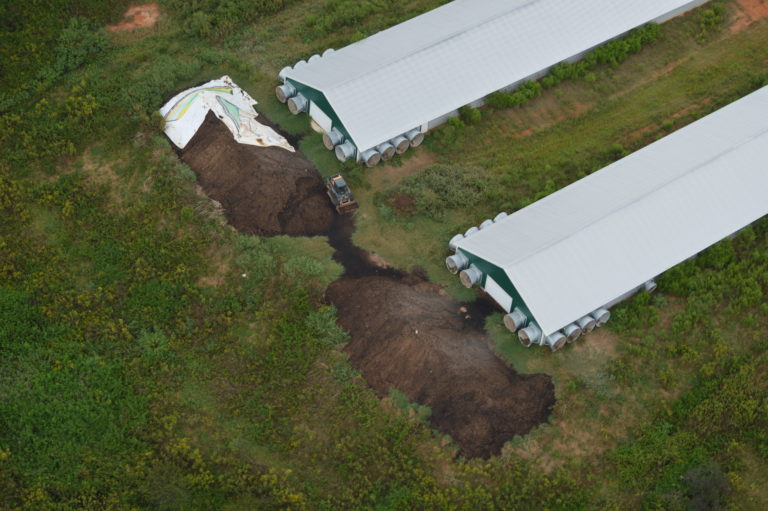It’s long past time NC takes action on pollution from poultry
By: Haw Riverkeeper

By Emily Sutton, Haw Riverkeeper
The unregulated poultry industry in North Carolina is burgeoning, with the number of chickens and turkeys increasing 17 percent in just the last 7 years to a total of more than 538 million.
This is a problem for the state’s waterways because all those birds produce nearly 5 million tons of waste — and no one knows where it goes.
Waste sits in massive piles, some directly next to streams. Piles can sit uncovered for weeks at a time, exposed to rain and wind. After sitting out, the waste is trucked to cropland, then spread.
But when Riverkeepers ask state agencies for information about the quantity of waste, and where it’s being applied, the state doesn’t have records to give us. This makes creating watershed-wide poultry waste management plans impossible.
This whole industry exists with next to no state oversight. Poultry waste is the state’s largest and fastest-growing source of nutrient pollution from animal agriculture, but the state doesn’t know how many poultry operations there are in North Carolina or how much waste is being spread where. The massive amount of pollution from poultry is not captured anywhere.
Each poultry operation is required to have a nutrient waste utilization plan, but those plans are not checked, certified, or turned in. We have no idea if those records exist at all. No one knows if the cropland where waste is spread can take up all the phosphorus and nitrogen from that waste, or if those pollutants will wash into the nearest waterbody the next time it rains. We don’t know where the manure is being spread, or at what rate.
With almost no publicly available records from the state, North Carolina Riverkeepers have been tracking new operations by air and by car. A lot of times, we see operations clustered in one sub-watershed, sometimes around one very small stream.
The runoff from that waste is a threat to public health, with high pH, ammonia, and dangerous levels of bacteria. This makes streams unlivable for macroinvertebrates and aquatic life, and dangerous for kids splashing around in them.
When the legislature reconvenes in January, it’s time for them to take action on this dangerous source of water pollution.
The law should require poultry facilities to submit to the state the nutrient utilization plans they’re already required to develop. These plans should be digitized and certified, reviewed, and approved. This will allow state agencies, and the public, to know where poultry waste winds up. As the Department of Environmental Quality has noted, when “the locations of dry litter poultry operations and the disposal of their waste are not known to environmental regulators” it is “difficult to form a complete picture of possible non-point source contributions within a specific watershed.” Transparency is a key step to understanding and solving this problem.
We also need siting requirements to keep the problem from getting worse, especially in vulnerable areas.
Too many poultry operations sit in the state’s floodplain, and more are being built. In Hurricane Matthew, 113 poultry facilities flooded. In Hurricane Florence, 441 barns were flooded. No new poultry facilities should be built in the state’s 500-year floodplain.
Siting limits should also take into account the volume and density of an area’s poultry operations. The poultry population in Duplin, Sampson, and Robeson counties grew by 30 million in eight years. This leads to significant air and water pollution is a condensed area, and has disproportionate impacts on low-income communities and communities of color. And too often, the cumulative effect of multiple operations in the same community is ignored. There has to be a ceiling on how many operations can open in a three-mile radius to limit the burden on these communities.
Next, we need a buyout for poultry facilities constructed within the 100-year floodplain.
We know from our work that there are 41 poultry facilities within the 100-year floodplain and another 74 Poultry Facilities within the 500-year floodplain. Operations that add to the pollution hardships disproportionately suffered by the state’s Black, Latino, and American Indian people should be at the top of the list for buyouts. Another buyout priority should be operations that are clearly polluting our waters.
The lack of regulations around poultry has allowed the industry to grow to a point where it poses a serious danger to the state’s land and waters. It’s long past time that we put reasonable limits on new poultry operations, sensible requirements on existing poultry operations, and started the work of buying out operations that sit on the state’s vulnerable flood plains.
Feature photo of two piles of poultry litter at an industrial poultry operation in North Carolina by Sam Perkins.